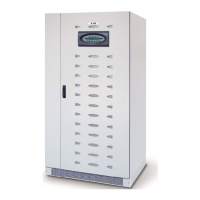page 12 / 75 0MNA080A55-GB REV 01
In order to ensure proper air circulation, and therefore the correct operation of the UPS, measures must be taken
during installation to avoid any obstructions to the free circulation of air. These include the following:
• ensure a distance of at least 60 centimetres from the ceiling, so as not to hinder air extraction,
• leave a free space of at least one metre at the front of the equipment to ensure both the circulation
of the air and installation and maintenance operations;
• With natural convection the thermal load is dissipated to the outside through the walls; thus a
cabinet placed against a wall or in a hollow dissipates less heat than one located in a free
environment.
The following rule must be observed:
leave at least one of the three side walls free: right, left or back.
• the side strips must not be mounted for installations where cabinets are placed side by side.
2.4 Air change for battery premises
The premises housing the battery cabinet must have sufficient air circulation to ensure that the concentration of
hydrogen issued during battery charging is kept below the danger limit.
The air change in the premises should preferably be provided by natural ventilation, otherwise by forced ventilation.
The standard EN 50272-2 for air change envisages that the minimum opening must satisfy the following equation:
A = 28 x Q = 28 x 0.05 x n x Igas x C10 (1/10³) [cm²]
where: A = free opening for air intake and outlet
Q = flow of air to be removed [m³/h]
n = number of battery elements;
C10 = battery capacity over 10 hours [Ah]
Igas = current that produces gas [mA//Ah]
in accordance with the standard: Igas = 1 VRLA type battery (*)
(*) for open vase or nickel batteries, contact the battery manufacturer.
When the equation is applied for 40 hermetically-sealed lead batteries:
A = 56 x C10 / 10³ [cm²]
When using 120Ah batteries, the minimum aperture should be:
A = 6.7 [cm²]
The air intake and outlet must be positioned to ensure the best possible circulation; for example:
- apertures on opposite walls,
- a minimum distance of 2 m when they are on the same wall.

